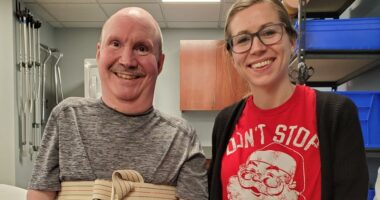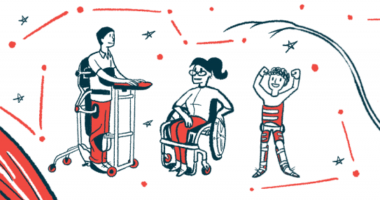When pain continues with new wheelchair, it’s OK to ask for help
Despite successes with various therapies, it's time to bring in other experts

As mentioned in previous articles, Michael, our patient who has spinal muscular atrophy, recently transitioned to a new power wheelchair. After this transition, Michael has experienced increased right hip and tailbone pain off and on with numbness down his right leg.
We have performed many activities with reduced pain in the tailbone as well as reduced symptoms down the leg, such as coccyx mobilizations, dry needling around the coccyx, and stretching of the lower extremities.
These activities would reduce the pain significantly from a few days to a week, although the pain continued to return. This pain was due to receiving a new cushion in his chair since the the old cushion was worn out and no longer being made. We discussed giving the new cushion a chance to form to his hips as he has severe scoliosis, although after two months, Michael’s pain and discomfort has become more intense.
He decided to reach out to his wheelchair company and inquire about options for his cushion. They have agreed to meet with me at our clinic while Michael is here to look at his cushion and discuss what may best benefit Michael and improve his comfort.
It is beneficial to have reach out to other resources when you are having difficulty with a topic you are not well versed in or you are unable to solve yourself. I don’t specialize in wheelchair fittings, nor do I have the tools or resources to provide the best cushion or customize the one he is currently using. Because of my lack of knowledge in this field, I am grateful to have someone else come into our treatment and work as a team to ensure Michael is getting the best care possible.
During this session, there will be measurements taken from tailbone down to his cushion to see where there is increased pressure. After that, there will be discussions of either cutting away some of the seat cushion to allow for reduced pressure on the tailbone or replacing the cushion altogether.
Once the decision is made, we will stay in touch with the representative so we can ensure Michael is comfortable for the long term. We will continue to monitor how his symptoms change, positive or negative, and what changes may be made with his alignment.
Ideally, Michael will notice immediate relief and be able to sit more comfortably for extended amounts of time. He may notice some soreness due to the change in the cushion but should overall experience reduced pain in his right hip and tailbone.
We also have discussed how to improve his work settings at home including possibly connecting his wheelchair joystick to his computer mouse. This would allow Michael to keep his hand on his joystick throughout the day and be able to move around the house and tilt his chair back into different positions to offload his tailbone for extended amounts of time independently. Both activities will attempt to further Michael’s independence and comfort throughout his daily activities.
Patient perspective
I can tell you from experience that sitting comfortably in your wheelchair for long periods of time is considered less of a luxury and more a necessity for those of us who are not able to walk. Now, with the onset of severe hip and tailbone problems, I’m finding that what used to be an occasional ache is turning into a life-changing experience.
My physical therapist Emily and I will be meeting March 26 with someone who is certified in seating for those who use wheelchairs. I’ve worked with this person in the past, and I’m hopeful that he’ll be able to give us some good ideas about different seating positions I can utilize throughout my day.




